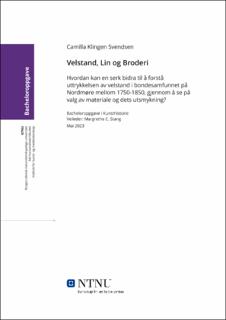| dc.contributor.advisor | Stang, Margrethe C. | |
| dc.contributor.author | Svendsen, Camilla Klingen | |
| dc.date.accessioned | 2023-07-11T17:24:32Z | |
| dc.date.available | 2023-07-11T17:24:32Z | |
| dc.date.issued | 2023 | |
| dc.identifier | no.ntnu:inspera:137214781:70863362 | |
| dc.identifier.uri | https://hdl.handle.net/11250/3077966 | |
| dc.description.abstract | Velstand, Lin og Broderi undersøker hvordan bondesamfunnet på Nordmøre uttrykte egen valstand mellom 1750 og 1850 igjennom en hermeneutisk analysemetode for å sette problemstillingen i en større kontekst innfor datidens samfunn. Serken som blir analysert kommer fra en godt dokumentert gård på Halsa, Utistu gård, hvor begge eierne innenfor den avgresede perioden hadde respekterte posisjoner i samfunnet og jobbet seg opp til gode økonomiske forhold. Serken er i svært god tilstand og er av 100% lin, samt rikt utsmykket på krage, mansjett og i hals med nordmørsøm. Nordmørsømmen hadde sin storhetstid i denne perioden, men da silke, fløyel og bomull ble tilgjengelig falt teknikken bort. Silke og fløyel var luksuriøse tekstiler og bomullen var lettere og billigere å produsere, samtidig gav det bedre resultater kvalitetsmessig. Lin på den andre siden var et helårsprosjekt fra såing av frøene til ferdig garn nøste og var en tilleggsnæring for flere bønder. Serken i sin tilstand i dag, omtrentlig 250 år etter den ble laget, bidrar til å forstå linen som bondens silke hvor fraværet av luksuriøse tekstiler bidrar til mer detaljarbeid i den mangflodige tekstilen og hvilket forhold en hadde til finklær på den tiden. | |
| dc.description.abstract | Prosperity, Linen and Embroidery examine how the farming community in Nordmøre expressed their own economic prosperity between 1750 and 1850 through a hermeneutic analysis method to put the issue in a larger context social context of that time period. The chemise that is analyzed comes from a well-documented farm in Halsa, Utistu farm, where both owners within the stated period had respected positions in society and worked their way up to good financial conditions. The chemise is in very good condition and is made of 100% linen, as well as richly decorated on the collar, cuffs and neck with Nordmør-stitching. The Nordmør-stiching had its time of greatnes during 1750-1850, but when silk, velvet and cotton became available, the technique fell out of fashion. Silk and velvet were luxurious textiles and cotton was easier and cheaper to produce. It also gave better results in terms of quality. Linen, on the other hand, was a year-round project from sowing the seeds to spinning the yarn and was an additional income for several farmers. The chemise in its condition today, approximately 250 years after it was made, helps us understand linen as the farmer's silk, where the absence of luxurious textiles contributes to more detailed work in available textiles. As well as the relationship the people had with their finer clothes at that time. | |
| dc.language | nob | |
| dc.publisher | NTNU | |
| dc.title | Velstand, Lin og Broderi | |
| dc.type | Bachelor thesis | |
